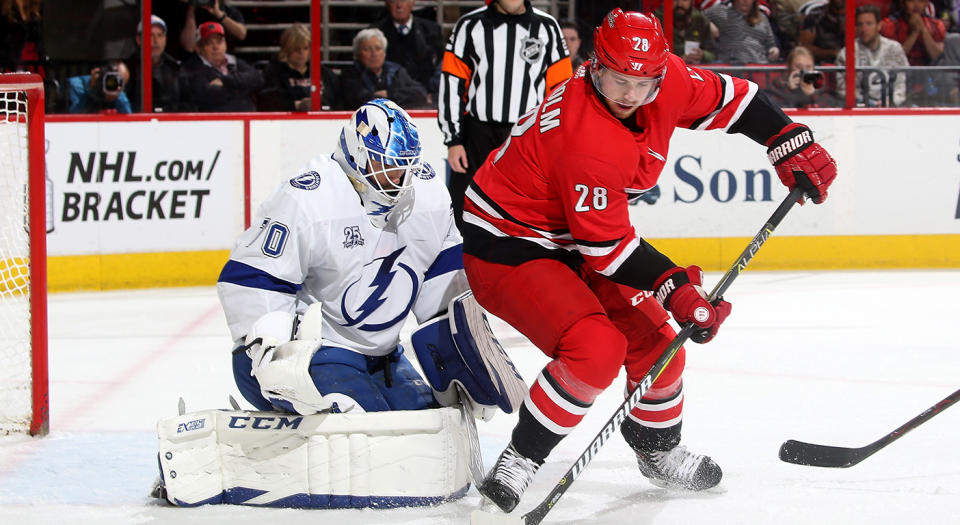Trending Topics: With new forwards in the fold, will Calgary break up 3M line?

The Calgary Flames knew they had a lot of areas they needed to improve this summer, and perhaps the most pressing was the team’s forward group.
To that end, GM Brad Treliving brought in Elias Lindholm (via trade) and James Neal (via UFA signing). These are two perfectly good top-six forwards who can be productive in a way that many of the Flames’ other forward options really haven’t been in the past two seasons.
If you want a list of their top-six forwards during that time, talent-wise, the Flames could really only offer five names: Johnny Gaudreau, Sean Monahan, Matt Tkachuk, Mikael Backlund, and Michael Frolik.
One might also argue for Micheal Ferland, who went to Carolina in the Lindholm/Hamilton/Hanifin trade, but I would note that if you only rack up 66 points playing a huge chunk of your minutes with Gaudreau and Monahan, that’s the barest amount of work you can actually do and still be considered an NHL player.
Anyway, bringing in Lindholm and Neal brings the grand total of legitimate top-six forwards on the Flames roster to seven, which you’ll note is one greater than the six they need. It’s never a bad thing to have seven top-six forwards, of course. All the best teams do. But where the Flames in particular are concerned, the dynamic has the potential to create an interesting ripple effect for the roster.
Over the past two seasons — which are delineated here because that’s when Tkachuk came into the league — the Flames’ top two lines have been pretty clearly defined. The top line was Gaudreau, Monahan, and literally any guy the coach felt wouldn’t fall down too often. The second line was the 3M line of Tkachuk, Backlund, and Frolik. Both were, to one extent or another, pretty effective. None of those five named forwards scored fewer than 69 points over the past two seasons, and while Frolik’s lack of offensive production is arguably a problem, it’s also worth noting that both of his linemates averaged close to 50 points a season in these last two campaigns.
Moreover — and this is the important part — the 3M line is and has been a possession juggernaut of a quality rarely seen in the league. Over the last two years, only eight lines have been together for at least 800 minutes at 5-on-5, and these three lead the way in ice time at almost 1,360 minutes. Their expected goal difference over that time is pushing 57 percent. Just as a point of reference, Boston’s big line of Patrice Bergeron between Brad Marchand and David Pastrnak — the best line in the league — is only a little more than half a percentage point ahead of the 3M boys.
Which is to say, this is probably a line you don’t want to break up, even if their actual goals-for number (55.3 percent) is a smidge below what they “should” score based on expected goals.
More to the point, they dramatically underperformed expected goals in the Flames’ no-playoffs 2017-18 campaign (58 percent expected, 46.8 percent scored) due largely to a killed combination of rotten shooting luck and worse goaltending, which added up to a PDO of just 96.8.
So the question for the Flames, and specifically new coach Bill Peters, is a simple one: What do you do with both Lindholm and Neal? One of them is going to have to take bottom-six minutes if you don’t break up the 3Ms, which you shouldn’t do.
It would seem the natural fit for a trigger man like Neal is to play alongside Gaudreau and Monahan because, well, they’re going to create a lot of open looks and if someone who is a proven scorer without elite talent gets put with elite talent, that’s only going to result in more goals.
Plus, the Flames extended Lindholm on a new six-year deal with an AAV of $4.85 million just yesterday. Solid number, maybe a little too long on the term; that’s the cost of doing business. But that’s not the kind of contract you give to someone who’s going to be getting third-line-and-second-power-play-unit minutes, y’know? (Not that Frolik, at $4.3 million against the cap, is exactly making bottom-six money either.)
Let’s talk this out, then. Frolik played more than 200 minutes away from his normal running buddies last season (and almost 620 with). All of Tkachuk and Backlund’s underlying numbers suffered, but their goals-for percentage did not. In fact, they went from getting outscored by three to outscoring by one, which is a swing of about 1.2 goals per 60 minutes.
Pushing a negative goal difference into positive territory is always a good thing, so it seems as though Frolik would be the natural pick to be bumped to the third line, with the option, one supposes of changing it back if things go sideways with one of the other lines.
But again, you’re talking about a roughly 11-point swing in expected and actual goal difference, and one wonders if the 3Ms scored as they did in 2016-17, if the Flames are even pressing this hard to sign two top-six forwards or trade Dougie Hamilton at all. I mean this is the difference between perceived and actual performance; if a baseball player hits it right at the center fielder or shortstop all season, it doesn’t matter how often he wasn’t striking out. People, even in baseball’s mostly smart front offices, aren’t gonna look deep enough to see his BABIP was x far below the league average if that x is a big enough number.
It seems to me the Flames perhaps went searching to solve a problem they didn’t have, but again, having talent on the roster is certainly preferable to not having it. I wouldn’t break up the 3M line with a gun to my head, but I at least see where the decision-making comes from here.
In fact, I even see the argument for moving Frolik, who’s a good, solid two-way forward, onto a line with Sam Bennett and Mark Jankowski in hopes of making them both more productive and less likely to concede goals. But whether that actually works out depends a lot on Lindholm’s performance. Not that you’d move Backlund for Lindholm (right???).
I don’t think they really counted on Tkachuk to be as effective over two seasons as he has been, and Backlund’s big-money contract is directly attributable to that effectiveness. This is a unit that went from just okay and maybe a little underwhelming individually to incredible thanks mostly to what Tkachuk brings to the table.
There are, potentially, a number of creative and effective solutions here, and Lindholm being able to play both center and the right wing really improves the team’s flexibility. The club had to do something about the previously awful forward group and it has. One just hopes they have the good sense to stick with what works extremely well even if luck sometimes goes sideways.
Put another way, the Flames have undoubtedly gotten better up front. But they’ve got one hell of a gift horse in that 3M line and it really seems like Treliving is looking it straight in the mouth.
Ryan Lambert is a Puck Daddy columnist. His email is here and his Twitter is here.
All stats via Corsica unless otherwise noted.

 Yahoo Sports
Yahoo Sports 


